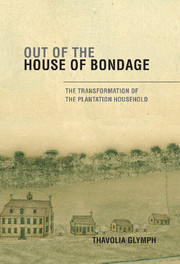Book contents
- Frontmatter
- Contents
- Acknowledgments
- Abbreviations
- Introduction
- 1 The Gender of Violence
- 2 “Beyond the Limits of Decency”
- 3 Making “Better Girls”
- 4 “Nothing but Deception in Them”
- 5 Out of the House of Bondage
- 6 “A Makeshift Kind of Life”
- 7 “Wild Notions of Right and Wrong”
- Epilogue
- Bibliography
- Index
- References
2 - “Beyond the Limits of Decency”
Women in Slavery
Published online by Cambridge University Press: 05 June 2012
- Frontmatter
- Contents
- Acknowledgments
- Abbreviations
- Introduction
- 1 The Gender of Violence
- 2 “Beyond the Limits of Decency”
- 3 Making “Better Girls”
- 4 “Nothing but Deception in Them”
- 5 Out of the House of Bondage
- 6 “A Makeshift Kind of Life”
- 7 “Wild Notions of Right and Wrong”
- Epilogue
- Bibliography
- Index
- References
Summary
Two-thirds of my religion consists in trying to be good to negroes because they are so much in my power, and it would be so easy to be the other thing.
Mary Boykin Chesnut, mistressOne day my mistress called fer me to come in to the house, but no, I wouldn't go. She walks out and says she is gwine make me go. So she takes and drags me in to the house. Then I grabs that white woman, when she turned her back, and shook her until she begged for mercy. When the master comes in, I wuz given a terrible beating with a whip but I did'ny care fer I give the mistress a good'un too.
Sophia Word, ex-slaveNature has done almost nothing to prepare men and women to be either slaves or slaveholders.
Frederick Douglass, ex-slaveThe plantation legend crafted before and after slavery enveloped mistresses in an aura of light and vulnerability, goodness and agreeableness, but slaves witnessed differently. Mandy Cooper failed to churn the milk fast enough and there was no butter for her mistress's noon meal. As punishment, she stated, “three white women beat me from angah [anger] because they had no butter for their biscuits and cornbread. Miss Burton used a heavy board while the missus used a whip.” She did not state what weapon the third woman used. Alice Shaw, assigned to fan flies and clear the table after dinner, dropped a dish. As punishment, her mistress beat her on her head.
- Type
- Chapter
- Information
- Out of the House of BondageThe Transformation of the Plantation Household, pp. 32 - 62Publisher: Cambridge University PressPrint publication year: 2003



